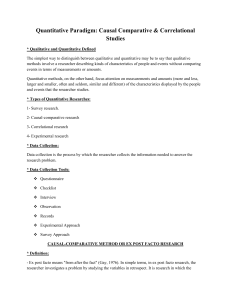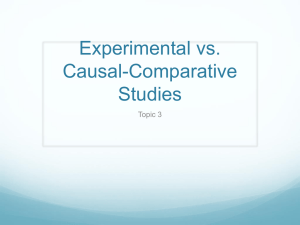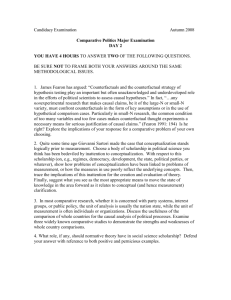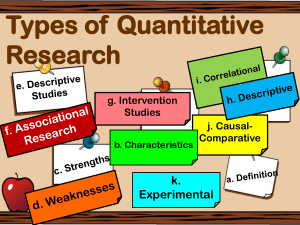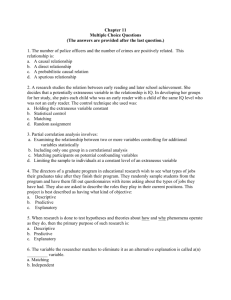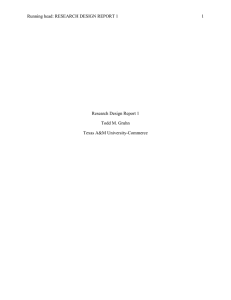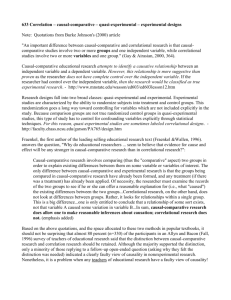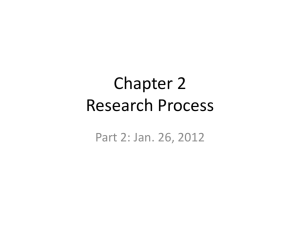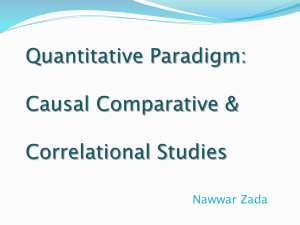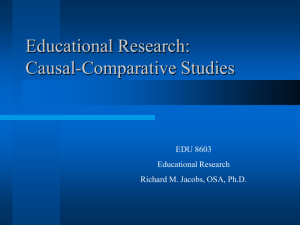Causal-comparative (ex post facto) research
advertisement
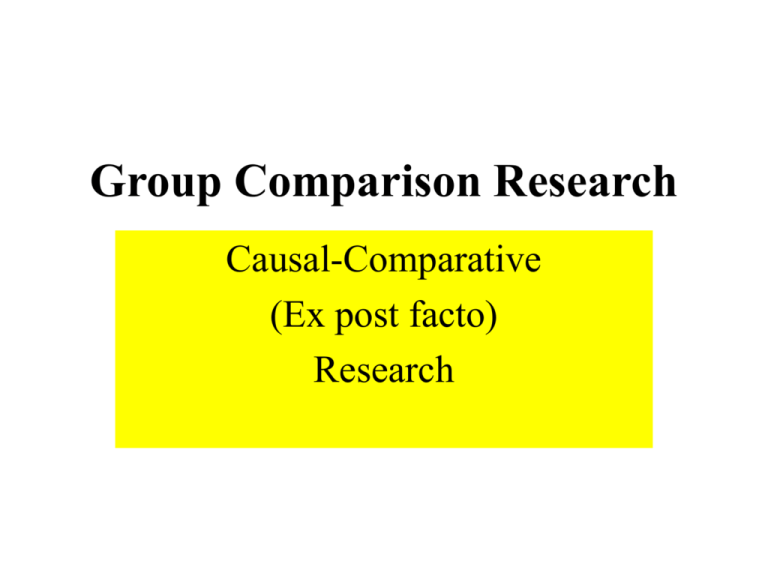
Group Comparison Research Causal-Comparative (Ex post facto) Research Purpose of causal comparative research • Attempts to determine cause for – Existing conditions – Preexisting differences in groups • Alleged cause and effect have already occurred • Orientations – Retrospective (basic): starts with an effect and seeks possible causes – Prospective (variation): starts with a cause and investigates its effects on some variable Causal-comparative (ex post facto) research • The independent variable (IV) is not manipulated; it has already occurred • Independent variables sometimes called “attribute variables” • Less costly and time-consuming to conduct • Establishing cause-effect relationships is more difficult than in experiments Procedures in causal-comparative research • Identify an existing condition or event (e.g., differences in socialization among 1st grade students) • Look “backwards” to see what may have caused this difference/condition to occur (i.e., some attended preschool, some did not) • Rule out other causal factors Sometimes confused with correlational research: • Both lack manipulation of variables • Both require caution in interpreting results • Both can support subsequent experimental research Causal comparative vs. correlational research • Causal comparative – Attempts to identify cause-effect relationships – At least one independent variable – Two or more groups – Involves a comparison • Correlational – No attempt to understand cause and effect – Two or more variables – Only one group Sometimes confused with experimental research: • Both try to establish cause-effect relationships • Both can test hypotheses concerning the relationship between an independent (X) and a dependent variable (Y) • Both involve group comparisons Comparison to experiments • Causal comparative – Individuals already in groups before study begins – Independent variable has already occurred – Independent variable is not manipulated • Cannot be • Should not be • Could be, but is not • Experiment – Individuals randomly assigned to groups (e.g., treatment or control) – Independent variable manipulated by the researcher Examples of non-manipulated independent variables • Age • Sex • Ethnicity • “Learning style” • Socioeconomic status (SES) • Parent educational level • Family environment • Type of school attended Design of causal-comparative research • Select 2 groups that differ on some IV – One group possesses a characteristic that the other does not – Each group possesses the characteristic, but in differing amounts • Randomly sample Ss from each group • Collect info on Ss to determine equality of the groups • Compare groups on the DV Difficulty in interpreting findings • Establishing cause and effect requires caution! • Alternative explanations: – Different causal variable – Order of causation • Reverse causality • Order of occurrence Evidence necessary to demonstrate that X causes Y: • Establish statistical relationship between X and Y (i.e., correlational research); • determine that X precedes Y in time (collect data over time, i.e., longitudinal research); • demonstrate that other, unknown factors did not determine the dependent variable (i.e., experimental research). Becker & Gersten (1982): “Effects of Project Follow-Through…” • Quasi-experimental study • Ex post facto study • Problem: Are the two groups in this study comparable to one another? In order to make sure that the two groups are comparable, and to ensure that the only post-test differences between the groups are due to the independent variable (the Follow-Through intervention), data were obtained on students’: family income gender language spoken in home mother’s education ethnicity number of siblings. Research Design • FOLLOW-THROUGH • Year 1 (1975) Gr 5 – – – – – Site 1 Site 2 Site 3 Site 4 Site 5 • Year 2 (1976) Gr 6 – – – – – Site 1 Site 2 Site 3 Site 4 Site 5 • NO FOLLOW-THROUGH • Year 1 (1975) Gr 5 – – – – – Site 1 Site 2 Site 3 Site 4 Site 5 • Year 2 (1976) Gr 6 – – – – – Site 1 Site 2 Site 3 Site 4 Site 5 Dependent variables • Wide-Range Achievement Test (WRAT) – reading – mathematics • Metropolitan Achievement Test (MAT) – reading – mathematics RESULTS • A total of 180 comparisons of FT to No-FT students. Of these, only 56 (31%) favored FT students! • Largest differences between FT and No-FT students were in basic skills areas. • FT students’ achievement declined by grades 5 and 6 (2-3 years after end of FT). Critique of this research • What are the strengths of the study? – – – – Groups are comparable to one another. Contrasted statistical with practical significance. Large sample size. Multiple “replications” of treatment effect. • What are the weaknesses of the study? – Lack of random assignment. – Focus on standardized test performance.
